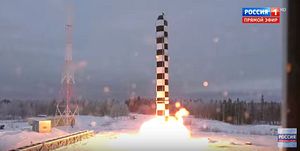The first serial produced super-heavy thermonuclear-armed RS-28 Sarmat (NATO designation: SS-X-29 Satan 2), Russia’s latest silo-based intercontinental-range ballistic missile (ICBM), is slated to enter service in 2021, according to country’s Deputy Defense Minister, Alexei Krivoruchko.
In an article for a trade publication published last month, the minister stated that “the first serial missiles will enter service in 2021.”
A regiment of the Strategic Rocket Force’s 62nd Missile Division, deployed in Uzhur, part of the 33rd Guards Missile Army, headquartered in Omsk in southwestern Siberia, will reportedly receive two silo-based RS-28 ICBMs in 2021 with four more ICBMs delivered in 2022.
“In total, seven regiments – with six missiles in a regiment plus one ten-missile regiment for a total count of 46 RS-28s – will be deployed and split up between two missile divisions based in Dombarovskiy and Uzhur,” I explained in October 2018. The RS-28 will slowly replace Soviet-era RS-36M2 Voyevoda (NATO designation: SS-18 Satan) ICBMs.
Other sources have claimed that a total of twenty Strategic Rocket Force regiments will receive the new ICBM.
To date, Russia has not made public any flight tests of the Sarmat ICBM, although in April, Russian President Vladimir Putin claimed that “the final tests of the missile Sarmat are proceeding successfully.”
Russia conducted the third and last ejection test of the RS-28 in May 2018. Two other ejection tests took place in March 2018 and December 2017. They involved the ignition of the ICBM’s first-stage and booster engine. The RS-28’s first stage engine is likely the PDU-99 — a modified version of the RD-274 liquid rocket engine used on the RS-36M2.
Flight trials would specifically seek to test the RS-28s second- and third-stage engines and take place at the at the Plesetsk space center, located in Arkhangelsk Oblast approximately 800 kilometers north of Moscow. At least five flight tests have been planned, according to Russian media reports.
The RS-28 is reportedly housed in a modified 15P718M silo launching system. The maximum range of the RS-28 is 18,000 kilometers. With a launch weight of over 200 tons, it can carry up to 10 multiple independently targetable re-entry vehicles (MIRV), each carrying a thermonuclear warhead.
The RS-28, with a total length of 35.5 meters and a diameter of 3 meters, is also reportedly capable of carrying hypersonic weapons, according to Russian President Vladimir Putin.
The operational deployment of the RS-28 is already over three years behind schedule. Putin had expressed his desire for the new ICBM to enter service this year already.
In early 2020, Russia was estimated to have 532 strategic launchers capable of carrying approximately 2,100 nuclear warheads.

































